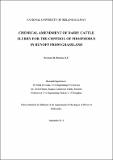| dc.description.abstract | Phosphorus (P) loss from grassland to a waterbody can adversely affect water quality.
Land application of dairy cattle slurry can result in incidental P losses to runoff in addition to increased chronic P losses from soil as a result of a build-up in Soil Test P
(STP). A literature review identified chemical amendment of dairy cattle slurry as a
possible mitigation measure to prevent such losses. This study comprised laboratory and field-scale experiments, which investigated the effectiveness and feasibility of chemical amendments in reducing P solubility, taking into account for the first time their pollution swapping potential.
First, a controlled agitator experiment was designed to identify the most effective
chemical amendment to reduce Dissolved Reactive Phosphorus (DRP) release to water
overlying grassed soil cores, which received un-amended and amended dairy cattle slurry.
In addition to effectiveness, the feasibility of these amendments was determined based on several criteria: estimated cost of amendment, amendment delivery to farm, addition of amendment to slurry, and slurry spreading costs due to any volume increases. The four best amendments based on effectiveness and feasibility, at optimum application rates were: ferric chloride (FeCl2), which reduced the DRP in overlying water by 88%,
aluminium chloride (AlCl3) (87%), alum (83%) and lime (81%). These amendments were then added to slurry immediately before it was surface applied to grassed soil in runoff boxes, which were subjected to simulated rainfall events. Analysis of overland flow showed that PAC (Poly-Aluminium Chloride, a commercially available form of AlCl3)
was the most effective amendment for decreasing DRP losses in runoff following slurry
application, while alum proved to be the most effective for total P (TP) and particulate P
(PP) reduction. The incidental loss of metals (aluminium (Al), calcium (Ca) and iron
(Fe)) in runoff during all experiments was below the maximum allowable concentrations
(MAC) for receiving waters.
Once the effectiveness of the amendments under laboratory conditions were quantified,
their ¿pollution swapping¿ potential was examined. A laboratory-scale gas chamber
experiment was conducted to examine emissions of ammonia (NH3), nitrous oxide (N2O), methane (CH4) and carbon dioxide (CO2). After considering pollution swapping in conjunction with amendment effectiveness, the amendments recommended for a micro plot study were, from best to worst: PAC, alum and lime. This component of the study investigated how soil and chemically amended slurry interactions affect amendment effectiveness under field conditions. The results of this micro-plot study validated the results from the laboratory-scale studies. Alum and PAC reduced average flow-weighted mean concentration (FWMC) and total loads of DRP, dissolved un-reactive phosphorus (DUP), PP and TP in runoff, while amendment of slurry with lime at the rate examined in this study was not effective at reducing P losses. Alum amendment significantly increased average FWMC of ammonium-N (NH4-N) in runoff water during the first rainfall event after the slurry was applied (an 84% increase). This indicates that chemical amendment of dairy cattle slurry conducted on a large scale could increase soluble N losses. Finally, a 9-month incubation experiment was conducted using five Irish grassland soils to examine the effect of amendments on the long-term plant availability of P in soil and the effect of soil type on the stability of reductions in P solubility. The study showed that, with the exception of FeCl2, the chemical amendments reduced water extractable phosphorus (WEP) without affecting STP.
This study showed that amendments are effective and that there is no major risk of
pollution swapping associated with alum and PAC. This is a significant finding as there is now potential to use amendments strategically, in combination with existing POM
(programme of measures), to mitigate P losses. The next step will be to examine the use of chemical amendments at catchment-scale. It is hoped that there will be economic incentives given to farmers to reduce nutrient losses. It is possible that P mitigating methods, such as chemical amendment of dairy cattle slurry, may be used strategically within a catchment to bind P in cow and pig slurries. | en_US |


